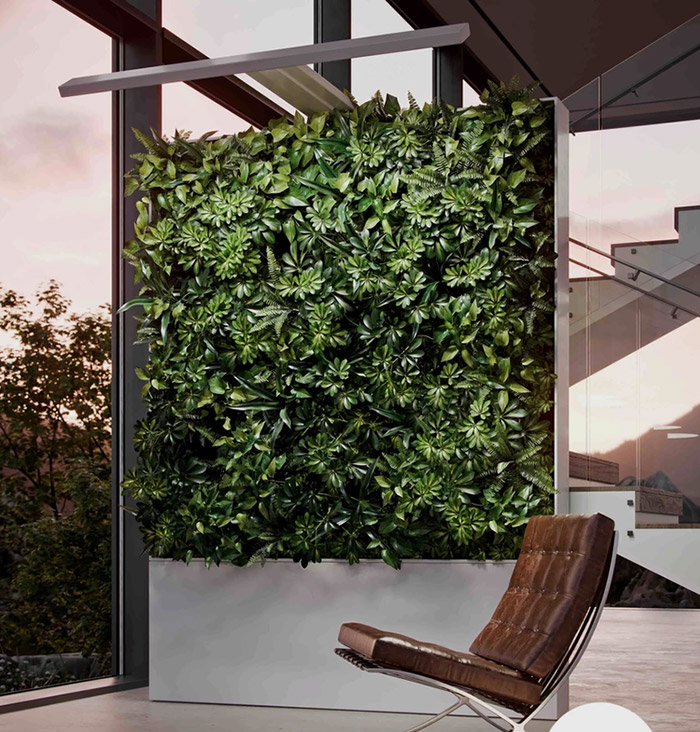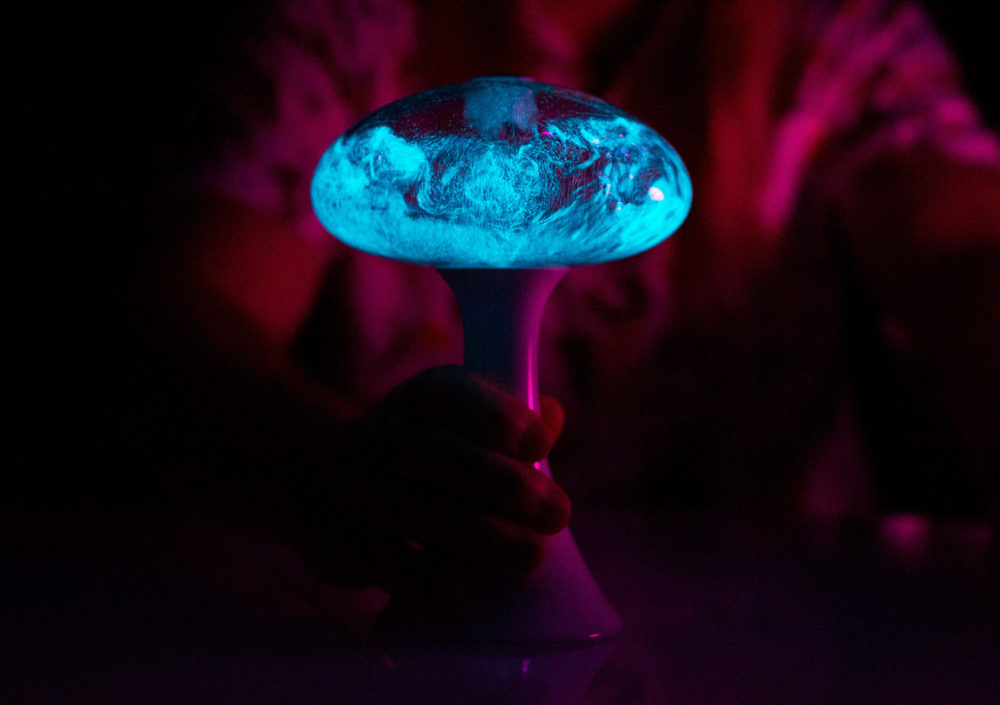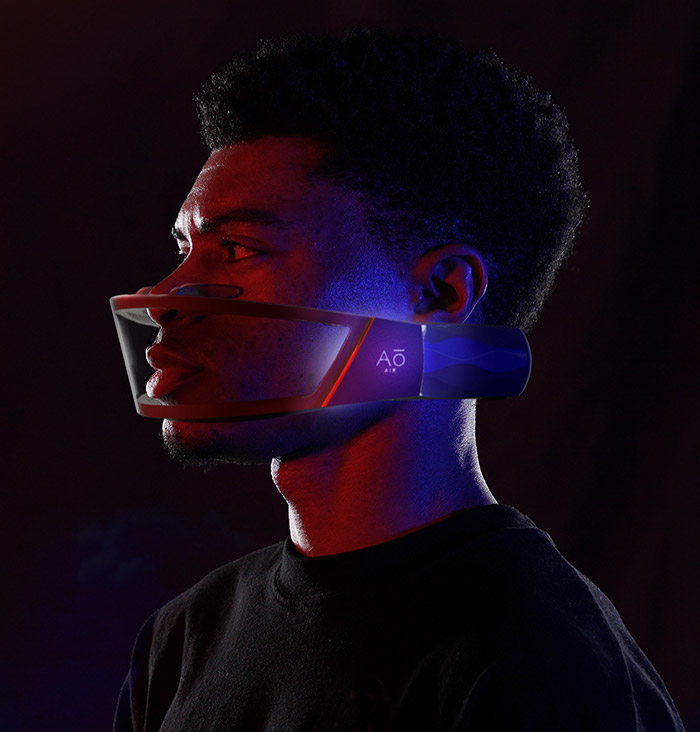Living design elements create a serene, multisensory, healing experience.
When scientist and inventor Andy Bass and his wife, Maryanne, first started farming bioluminescent dinoflagellates in 2011, they were attempting to make a living light: A simple home appliance powered entirely by plankton.
After many years and various prototypes, the Mushlume UFO, the Bass family’s latest version of dinoflagellate homewares, will soon be available for purchase. The shroom-shaped aquarium houses tens of thousands of tiny, single-celled organisms, which when gently swirled inside their sealed container glow in the dark, mimicking the stunning effect of a natural phenomenon in your home.
“I think getting to the idea about how we can live in a biological world is the essence of what I’m getting at,” says Bass, who lives north of San Diego, an area where dangerous dinoflagellate blooms have caused toxic red tides in the past. “I want the way that I’m designing to bring people into the biological world in a fun way.”
The birth of biodesign
As biotechnology advances past the lab to the sketchbooks of designers and into our living rooms, it may have seemed inevitable that the field of biodesign emerged, an interdisciplinary and somewhat nebulous specialty that beacons to artists, scientists, technologists, and those like Bass who wear multiple hats.
A growing number of contemporary artists and biodesigners experiment at this nexus of the living world and art, and the clothing, lighting, and furniture of Neri Oxman, Studio Drift, Eric Klarenbeek, and others have become part of the fabric of the design world and the inspiration for organically inspired interiors.
But as life follows art, biophilic architecture and interior design are emerging from the quiet confines of galleries and into the mainstream chaos of our everyday work and living spaces. The trend toward biophilia, or the concept of incorporating nature and natural elements into our lives, couldn’t come at a better time. As we’re all stuck in our homes because of the pandemic, taking shelter in spaces that we didn’t design for full-time occupancy, it may be that our lack of interaction with the natural world is taking its toll on our physical and psychological health.
It may be that our lack of interaction with the natural world is taking its toll on our health.
Luckily, a slew of new products use innovative technologies to augment or substitute for the big wide open, so we can feel the calming influence of nature even when we are trapped at home. When biology, technology, and nature intersect in design, the outcome is a trend in novel, nature-inspired homewares that can elevate a space to rival the best galleries, even on a modest budget. Nature can also serve as a distraction from our screens, an excuse to take a beat, relax, and breathe, away from the constant chatter of social media or the crushing anxiety of the 24-hour news cycle.
A recent study showed that interacting with an aquarium, even for a short time, can provide numerous physiological, emotional, and cognitive benefits. Similarly, numerous other studies have shown that clean air, indoor plants or greenery, and particular kinds of light can have an enormous impact on our moods and bodies.
Sally Augustin, an applied environmental psychologist who specializes in the benefits of biophilic design, says that the best approach for implementing nature into design is a multisensory one.
“Most of us are having a range of sensory experiences at any one time,” she says. Design shouldn’t overwhelm any of the senses and should take into consideration the way a person might respond to a space and all the various inputs it offers, like the many ingredients in a bouillabaisse.
Simplify the space, ease the mind
Biophilic design at home, according to Augustin, includes thinking about the design principles that nature applied in the places where we felt really comfortable in our early days as a species, and then applying those principles in our modern living spaces.
One example of this, says Augustin, is incorporating views of natural spaces, similar to what early humans would see when they looked out from caves and trees. Our minds are designed to scan the views to look for things we find safe and comforting—and which have low visual complexity. So, a room with an open window, a couple of plants, and some subtle wood grain is better than a chaotic, cluttered space without natural light. Simply put, our brains are at their best when they can quietly observe aspects of the natural world.
In Green Class, a project from 3D-design consultancy Loftgarten, viewers are invited to sit for dinner and a show in a large auditorium filled with soft, luxurious couches, subtle lighting, and a giant open window the size of a cinema screen. However, instead of watching a movie, the audience takes in a view of the jungle just outside, complete with mossy rocks, giant ferns, chirping insects, and a waterfall.
Loftgarten Creative Director Paul Milinski says the idea is to encourage guests to sit together and enjoy nature over a meal. “It offers a chance to connect with the ones [you] love and the environment at the same time. It also provides a break from our nonstop noisy lives and an opportunity to be mindful,” he said in an email exchange.
Green Class is still a conceptual prototype. It doesn’t yet exist in the real world. But the idea behind it is a multisensory experience combining nature sounds such as birds and running water from the stream mixed with light, relaxing lo-fi music. This “hybridization of indoor and outdoor entertainment” allows viewers to immerse themselves into a unique experience.
Green Class is a striking idea, despite being an as-yet-unrealized fantasy. The images Milinski creates of cavernous hotel lobbies, lush rooftop treehouse restaurants, homes with glass walls, and a lounge chair immersed in a lush forest are examples of speculative biophilic design of the near future, he says—features of homes that will soon be attainable.
“Most elements I use already exist,” Milinski says. What doesn’t exist is the pairing of those elements with the contexts in which they sit to create a natural living space that offers a break from our nonstop noisy lives.
“Somewhere along the human timeline, we have disconnected from nature,” he says. “The truth is, we are just as much a part of nature as a bird, tree, or sunset. We can reconnect with this truth, prioritise biophilic design, and have it be a constant reminder of our origins and a sign of a better future.”

This is certainly a vision for the future that other biophilic designers have caught on to, and plenty of designers have created real-life versions of Loftgarten’s vision for smaller scales with bio-inspired art and entertainment created especially for the home to give our minds and bodies a break.
“There is something so simple, so beautiful about even a house plant,” says Zachary Smith, a designer and CEO of Chicago-based biophilic architecture firm Zauben, which designed the Model Z, a green wall priced at a whopping $7,500 that was recently named as one of Time magazine’s Best Inventions of 2020. “Plants make us happier. If we can provide that in a way that is unique and new and exciting, that’s what we’re marching to the beat of,” Smith says.
Companies like Up the Wall Gardens also install manageable, beautiful, green walls for homes and offices. Artists like those found on Etsy or at local fairs are also a good bet for scratching a biophilic design itch without breaking the bank. And for those who may just want a couple extra plants without the fuss of installing a whole wall of greenery, Bass has another project: Urbz, a compact gardening system that allows DIY farmers to grow bunches of herbs in small plastic orbs or clear oblong planters that stick to any glass surface using biomimicry. (The sticky glue was inspired by the ways geckos climb up walls and doesn’t leave a residue.)
“It has been very satisfying when you see your plants thriving and you feel responsible for this living thing,” says Bass.
Bass says he has about 30 Urbz planters in his home and that they make him and his family feel “more dialed in” to the natural world because the clear plastic allows them to watch the roots grow and follow the processes of his plants.
Stepping into the light
It’s not only plants that can tickle our senses and connections to nature. Light, too, has immense health benefits—especially in the Northern Hemisphere at this time of year. Large windows and smooth, expansive glass panes are stalwarts of biophilic design.
Augustin, who regularly works with interior designers and architects to incorporate biophilic design principles, says that for those living and working in urban homes without much natural light, it can be draining to be indoors.
“Natural light is like getting some sort of magic medicine,” she says. “Our mood improves, and the performance of our brain improves.”
Hard on the heels of the popularization of indoor LEDs, a movement for innovative and invigorated lighting design has emerged that takes its cues from nature but with a technological twist: circadian lighting. Circadian rhythms are the natural up-and-down patterns of gene expression in humans, plants, and other organisms that keep us timed to the 24-hour solar cycle. Disrupting your circadian rhythm by working graveyard shift or flying across time zones can wear on your health and mood.
“Circadian lighting really helps you keep track of where you are on the planet,” says Augustin. When you lose track of that, she says, “You can get stressed out.”
One of the ideas behind circadian lighting is altering the color temperature and intensity of lights throughout the day. Colored light can have mental health benefits, according to a recent study, and biophilic design experts, including Augustin, say that exposure to different colors of light can have different results. For a more cozy and relaxing vibe, warmer colors, like oranges, can help set the mood when they are placed at lower heights, such as on tabletops. For this effect, look for lower kelvins, such as 2000k to 3000k. To increase alertness and productivity, cooler colors of light will do the trick, such as bright whites that can almost look blue (these can be up to 6500K), especially when they’re placed into the ceiling. Augustine suggests checking out a general purpose store (such as Target) for a large selection of bulbs with clear glass globes that are labeled cool or warm.
Dinoflagellates also have a circadian rhythm, says Bass. Part of the Mushlume’s design is based on the natural diurnal cycle of the plankton, which only luminesce at night.

Personalizing the air you breathe
Smells and air should also be incorporated into nature-inspired design, says Augustin. The human olfactory system is capable of detecting hundreds of thousands of different chemical odors, even in trace amounts. And scents landing in the nose will trigger neuro signals in those same parts of the brain involved in forming memories and feeling emotions—a fact that practitioners of massage and aromatherapy have exploited for years. But the absence of foul or moldy smells can be just as important as the presence of sweet ones, so clean, modern air purifiers and scents can do wonders to improve focus or instill a sense of calm.
During bad episodes of smoke and smog in places like California or China, air quality even inside the home can be poor. So companies like Ao Air are developing the future of air purification technology, beginning with their futuristic Atmos face covering, which makes your mouth look like a refugee from a 1980s new wave band. According to the company, this is no mere passive filter but sophisticated tech. Atmos uses 16 sensors and a proprietary algorithm to constantly clean the air the wearer breathes, and while it’s still in the early days, there are a slew of potential benefits, especially now that mask wearing is ubiquitous.

Ao Air cofounder Ilya Vensky says that the future of personalized air purification in the spaces we inhabit, like homes, offices, and gyms, is on the cusp of a revolution. He’s careful not to make any untested claims that his product can protect against coronavirus or any other airborne pathogen, but he does say that the Atmos technology is a game changer for ambient air quality.
“We’re moving toward a more invisible design that protects you and informs you,” says Vensky.
He’s looking toward a future where breath analytics can tell as much about a person’s health as blood markers. Eventually, he says, it won’t be about just seeking to escape pollution, smoke, and other drivers of poor air quality or to create bubbles of clean air. It will be about personalizing the air you breathe so that every breath is dialed to your specific health need, activity, or mood. Breathing the air in your home of the future may not be mere biological necessity. It may become a mood-elevating experience.
Until then, simply clean air will do.
























